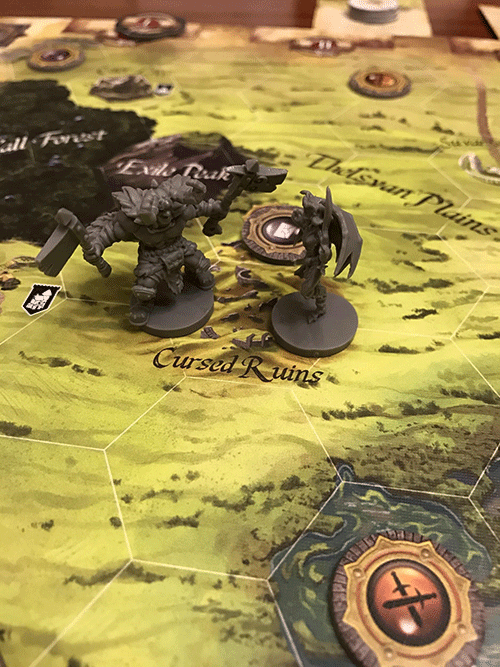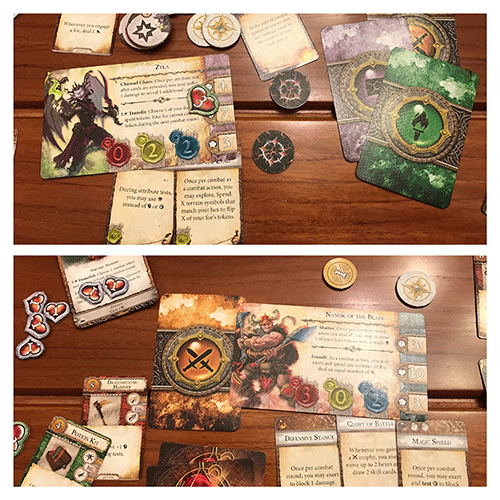Runebound Wave 2 Review
on Oct 27, 2016

Runebound: Fall of the Dark Star: 
Runebound: Mountains Rise: 
Prophets mutter curses and keep their eyes on the black moon. The mountains rumble as Giants and Trolls are spotted all over Terrinoth. Rumors swirl of a Barbarian rampaging in the south and an eyeless Fae demon wizard in the North. The Mountains Rise and Fall of the Dark Star are the latest adventure pack and scenario for FFG’s Runebound 3e and they bring with them a pile of new stuff. This is both bad and good, though overall I’m happy with these two smallish expansions.
I mentioned in my initial review that the systems of Runebound seemed readily able to accept expansions. As expected, integrating the new adventure cards and items is narratively seamless. Part of what makes Runebound so fun is how flexible the base systems are. The Mountains Rise ups the difficulty from the standard core set by giving monsters like Giants and Trolls powerful Surge abilities that can trigger off the same monster tokens from the core. Coupled with some of the other tools in the box, they can provide a surprisingly clever narrative element. Giants have the ability to cause an avalanche: for the low cost of a couple surge tokens they can do up to 5 unblockable damage to your explorer. The clever twist to this ability is that the player gets to roll terrain dice as if they were moving. Every mountain dodges a point of damage.

Nanok and Zyla face off.
For the imaginative player, this conjures up the image of Nanok the Barbarian deftly dodging boulders and climbing over new ravines in his battle with the Giant. For more mechanically inclined players, it’s a new twist to combat without adding more bits. Quests in the Mountain’s Rise occur more often in Mountain spaces and require Mountain results on the dice. They’re harder, but more rewarding. Expanding the multiuse nature of the core components is welcome. While a complete experience, the Runebound base set is as full of promise as it is adventure and little twists like this are encouraging after the slightly underwhelming first wave of expansions.
It isn’t just the Adventure pack that is an improvement this time around. Dan wrote in his review of the previous packs that he was disappointed that the scenario featured yet another Big Bad Evil Person rampaging across the board to the capital and destroying it. He’ll be happy to know that things are quite different this time around. While Tamalir can be destroyed again, this time it happens due to a story card. Losing one of the 4 major cities (and the associated item market) early in the game makes for a dramatic change in strategy and is hits a strong narrative beat. Fall of the Dark Star is a dark scenario full of whispered portents of doom and curses befalling the players.
There are no static markers to find or specific monster families to fight. Adventure decks are littered with opportunities for the players to collect Prophetic Visions, represented by the white tokens that come in the base game. Once enough are collected, they can be traded in for Dark Shards. These add a few hp per shard but also come with Corruption cards. These will do everything from prevent heroes from entering Shrines to dealing direct damage at the beginning of every battle. In theory, I really like this idea of these decisions. Extra health is nothing to sneeze at, and is almost always worth the Corruption. However, spare Prophetic Visions can be cashed in to remove the curses while keeping the shards. The scenario cards do a great job of throwing these tokens at players so that they can engage with the mechanic but the downside is making it too easy to remove these negatives. There is little reason to opt to avoid the Dark Shards.

New items, cards, and skills are here to clutter up your table
What really makes this scenario shine though is the ending. No dragon or leering necromancer here; your final battle is against the other players. Fall of the Dark Star brings with it rules for multi-player combat. The scenario ends with the dark prophecies coming true. At the end of the battle royale only one hero will remain. Battling your opponents is a lot of fun and I enjoy a scenario that gives up on the thin pretense that there is a benefit to cooperating in Runebound. Knowing that you aren’t just racing your opponents to defeat a Big Bad, but are in fact going to find yourself in direct and bloody competition with them at the end really raises the stakes on your adventure. Failing a combat or quest feels even worse when you just watched your opponent buy a fancy new suit of armor.
My biggest problem with the Runebound expansions, all of them, is the additional time it adds to set up and tear down. Having to separate and organize all the various skills and items into groups only to reassemble subsets of them each game takes away from the Core Set’s ease of going on an adventure. Coupled with the cost of the expansion, this drops them from being a must-buy. That being said, I’m going all in. Runebound is a great fantasy adventure game and these two expansions are both exciting and hone a fresh edge to the system. If future expansions follow in their footsteps, I’ll continue exploring Terrinoth as long as FFG keeps printing fancy new cardboard pogs.

 Customer Support
Customer Support  Subscribe
Subscribe 




 Account
Account  Wishlist
Wishlist 
